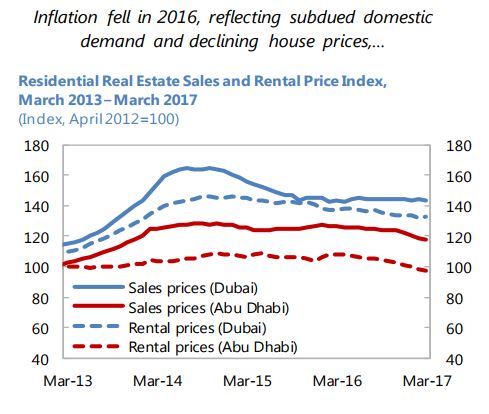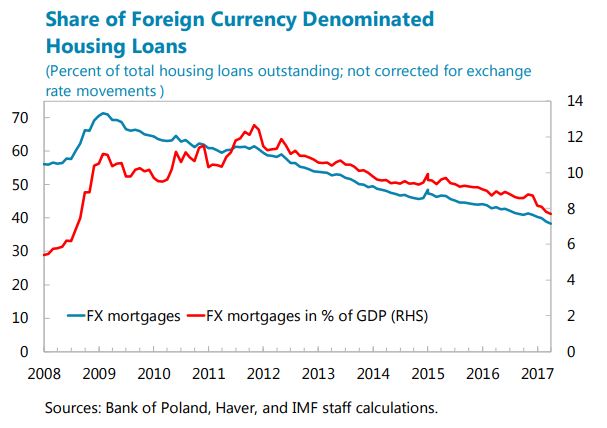Tuesday, July 18, 2017
Housing in United Arab Emirates
The IMF’s latest report on United Arab Emirates notes that “The authorities expect housing market to bottom out in 2017, in part due to Expo 2020 investment. Discussions with market analysts suggest that the real estate market is close to balance but is facing headwinds ahead because of rising supply, government’s fiscal restraint, higher interest rates, and stronger exchange rate.”
The IMF’s latest report on United Arab Emirates notes that “The authorities expect housing market to bottom out in 2017, in part due to Expo 2020 investment. Discussions with market analysts suggest that the real estate market is close to balance but is facing headwinds ahead because of rising supply, government’s fiscal restraint, higher interest rates, and stronger exchange rate.”
Posted by at 5:14 PM
Labels: Global Housing Watch
Housing in Poland
The IMF’s latest report on Poland notes that “the stock of foreign-currency mortgages continues to decline”.
The IMF’s latest report on Poland notes that “the stock of foreign-currency mortgages continues to decline”.
Posted by at 5:09 PM
Labels: Global Housing Watch
Monday, July 17, 2017
Housing View – July 17, 2017
On cross-country:
- How Advanced Economies Tackle Housing Market Imbalances: Lessons for Canada – IMF
- Confronting the Urban Housing Crisis in the Global South: Adequate, Secure, and Affordable Housing – World Resource Institute
- Housing and the tax system: how large are the distortions in the euro area? – European Central Bank
On the US:
- Homeownership and the Racial Wealth Divide – Federal Reserve Bank of St. Louis
- Are Immigrant and Minority Homeownership Rates Gaining Ground in the US? – SSRN
- HUD Secretary Shaun Donovan on all things housing – Milken Institute
- Linking Residents to Opportunity: Gentrification and Public Housing – US Department of Housing and Urban Development
On other countries:
- [Australia] The Rise and Rise of Medium Density Housing – CoreLogic
- [Canada] Macroprudential Tools at Work in Canada – IMF
- [Ghana] Housing transformation and livelihood outcomes in Accra, Ghana – ScienceDirect
- Israel Faces End of Decade-Long Housing Boom – Bloomberg
- [Japan] The Reverse Mortgage Market in Japan and Its Challenges – U.S. Department of Housing and Urban Development
- [Norway] Chart of the Week: Norway’s Home-Price Boom – IMF
- UK Residential Market Update – Knight Frank
- [United Kingdom] English Housing Survey 2015 to 2016: potential for stock improvements – UK Gov
On cross-country:
- How Advanced Economies Tackle Housing Market Imbalances: Lessons for Canada – IMF
- Confronting the Urban Housing Crisis in the Global South: Adequate, Secure, and Affordable Housing – World Resource Institute
- Housing and the tax system: how large are the distortions in the euro area? – European Central Bank
On the US:
- Homeownership and the Racial Wealth Divide – Federal Reserve Bank of St.
Posted by at 5:00 AM
Labels: Global Housing Watch
Thursday, July 13, 2017
Inequality in Brazil: A Micro-data Analysis
A new IMF report says that “Over the past decade or so, Brazil—a still highly unequal country—has been the poster child for social mobility. According to the World Bank’s international poverty line, Brazil slashed poverty from 25 percent of the population in 2004 to 8.5 percent in 2014. Extreme poverty declined from 12 to 4 percent over the same period. As millions were lifted out of poverty, the middle class was boosted. The commonly used inequality measure – the World Bank’s Gini coefficient (the closer to 1, the more unequal) – declined from 0.60 in 1990 to 0.51 in 2014. Inequality reduction was achieved thanks to a decade-long period of economic growth and deliberate income and social inclusion policies, such as minimum wage increases and targeted social programs. Yet, inequality remains high: based on data from the 2014 Pesquisa National de Amostra de Domicílios (PNAD), labor income of the population in the top decile of the income distribution corresponds to 40 percent of labor income of all Brazilian families, the top 1 per cent receives about 12 percent, and the top 0.1 per cent around 2.5 percent. Half percent of all labor income is concentrated in the top 0.01 percent.”
Continue reading here.
A new IMF report says that “Over the past decade or so, Brazil—a still highly unequal country—has been the poster child for social mobility. According to the World Bank’s international poverty line, Brazil slashed poverty from 25 percent of the population in 2004 to 8.5 percent in 2014. Extreme poverty declined from 12 to 4 percent over the same period. As millions were lifted out of poverty, the middle class was boosted. The commonly used inequality measure – the World Bank’s Gini coefficient (the closer to 1,
Posted by at 6:36 PM
Labels: Inclusive Growth
Staying the Role Model: Advancing Gender Equality in Rwanda
From a new IMF report:
“Rwanda has been one of the fastest growing economies in sub-Saharan Africa, and emerged as a global leader in promoting gender equality. Over the past ten years, economic growth has averaged 7.7 percent, with per capita income close to doubling to $729 in 2016. Between 2004 and 2014, the poverty rate declined by almost 18 percentage points to 39 percent while extreme poverty declined to 16 percent.
Rwanda’s advances in gender equality emerged, in part, as a necessary component of the rebuilding and development strategy from the mid-1990s, with women taking on new roles as major actors in society and heads of households. Today, the role of Rwandan Women is celebrated, as evident in many aspects elaborated further in this paper. Gender equality as an integral component of its development agenda—with advocacy at the highest level, constant engagement in programs to enhance economic opportunities for women, home-grown solutions to address gender inequality, an enabling legal framework and supporting institutions—such as a dedicated gender “machinery”: the Ministry of Gender and Family Promotion, the Gender Monitoring Office, the National Women Council, and the Forum for Women Parliamentarians. The provision of gender disaggregated data has increased (NISR 2016: National Gender Statistics Report), and allows a timely assessment of the main indicators.
In parallel, indicators of gender equality have improved significantly (Figure 4), and the World Economic Forum’s 2016 Gender Gap Index ranks Rwanda number 1 among all low-and-middle-income countries in closing the gender gap. Rwanda also positioned itself as number 5 worldwide, and one of only five countries to have ever reached a score of more than 80 out 100. Globally, Rwanda also ranks second in the UN’s 2015 Gender Development Index and has the lowest level of gender inequality, as measured by the Gender Inequality Index in sub-Saharan Africa.”
Continue reading here.
From a new IMF report:
“Rwanda has been one of the fastest growing economies in sub-Saharan Africa, and emerged as a global leader in promoting gender equality. Over the past ten years, economic growth has averaged 7.7 percent, with per capita income close to doubling to $729 in 2016. Between 2004 and 2014, the poverty rate declined by almost 18 percentage points to 39 percent while extreme poverty declined to 16 percent.
Posted by at 1:53 PM
Labels: Inclusive Growth
Subscribe to: Posts







